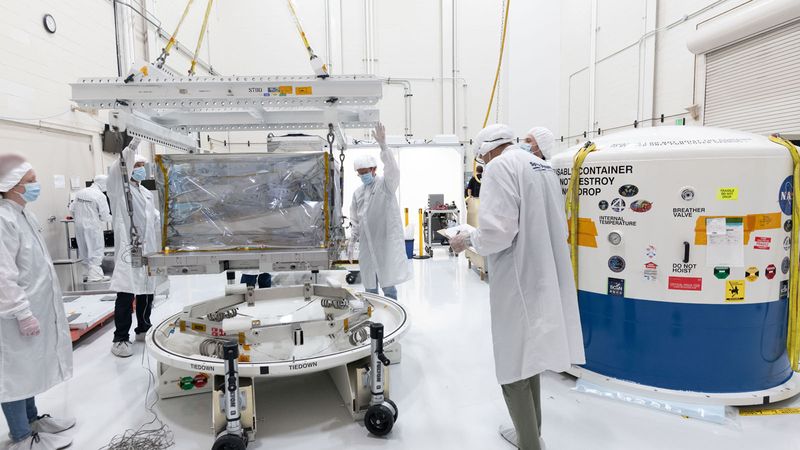
SDL employees are shown in this Aug. 15, 2023, image at SDL facilities on USU’s Innovation Campus preparing the Atmospheric Waves Experiment, or AWE, instrument for containerization and shipment to Kennedy Space Center. (Photo Credit: SDL/Allison Bills)
Utah State University’s Space Dynamics Laboratory achieved a significant milestone for NASA’s Atmospheric Waves Experiment, or AWE, as the mission readies for a Nov. 1, 2023, launch to the International Space Station. In a pivotal step toward advancing atmospheric research, SDL delivered the cutting-edge AWE science instrument to Kennedy Space Center and completed initial processing.
“AWE’s arrival and processing at Kennedy Space Center marks a critical juncture in USU’s quest to decode the intricacies of Earth’s atmosphere,” said Burt Lamborn, AWE project manager at SDL. “Designed to unravel the mysteries of atmospheric gravity waves from the vantage point of the ISS, the SDL-built science instrument carries the potential to revolutionize our understanding of climate dynamics and their underlying mechanisms.”
The primary objective of the AWE mission is to better understand atmospheric gravity waves (AGWs) within the ionosphere-thermosphere-mesosphere system, spanning altitudes from 50 to 500 kilometers above Earth’s surface. This atmospheric region is where Earth weather and space weather meet. The ionosphere in particular harbors charged particles that can cause considerable disruption to our space-based communication infrastructure. Through an investigation of AGWs, researchers aspire to enhance their understanding of how Earth’s weather dynamics impact the characteristics of the upper atmosphere.
AGWs materialize as surges of air primarily generated by terrestrial weather disruptions, including intense thunderstorms, hurricanes, or the upward rush of winds over mountain ranges. As they progress, these waves eventually dissipate their energy — like ocean waves crashing upon a shore — as they propagate upward into the ionosphere. Operating from a low Earth orbit positioned roughly 400 kilometers above our planet’s surface, AWE will survey the globe using an imaging radiometer. This instrument will yield detailed temperature maps of AGWs near the mesopause, situated at the upper boundary of the mesosphere. Armed with this valuable data, scientists can extrapolate the broader implications of gravity waves within the ionosphere-thermosphere-mesosphere realm.
AWE’s journey — from the initial concept by Dr. Michael Taylor, USU physics professor and AWE principal investigator, to instrument design, manufacturing, and testing at SDL, and finally delivery to Kennedy Space Center — was meticulously planned and executed, reflecting the significance of the mission. The first crucial step in AWE’s voyage to Kennedy Space Center was the process of containerization. Skilled technicians secured the instrument within a specially crafted container. This containment ensured the instrument’s protection from the rigors of transportation, shielding it from temperature fluctuations, vibrations, and potential impacts that could compromise its delicate calibration.
Once cocooned in its protective casing, AWE embarked on the first leg of its eventual journey to the ISS, traversing the miles from SDL’s Utah campus to Kennedy Space Center. Monitors within the container recorded temperature, pressure, humidity, and vibration data during travel. Upon arrival, the instrument was removed from the shipping container, transported to a clean processing area, and tested to ensure that it was in proper working order and ready for subsequent pre-launch activities, scheduled to start at the end of September.
AWE’s trajectory from SDL to Kennedy Space Center, marked by the careful steps of containerization and preliminary processing, underscores the dedication of many people to the pursuit of space exploration. AWE’s impending mission to decode atmospheric mysteries reminds us that scientific progress knows no bounds and that our understanding of the universe is limited only by our determination to seek answers.
AWE is a Mission of Opportunity under NASA’s Heliophysics Explorers Program, which conducts innovative, streamlined scientific investigations by developing instrumentation to answer focused science questions that augment and complement the agency’s larger missions. AWE joins a fleet of heliophysics missions positioned at key places around the solar system, which together seek to understand the way the constant outflow of energy and particles from our Sun affects interplanetary space — information that not only teaches us more about our astrophysical neighborhood, but helps protect astronauts and technology in space.
For more information about the AWE mission, visit www.atmosphericwaves.org.
USU’s Department of Physics is among six academic departments of the College of Science. As part of a land- and space-grant university, the college’s mission is to create, share, and apply new knowledge to inspire scientific solutions to global challenges. USU physics students develop valuable research and critical thinking skills with professors engaged in world-class research programs. For more information, visit www.physics.usu.edu.
Headquartered on Utah State University’s Innovation Campus in North Logan, UT, the Space Dynamics Laboratory is a nonprofit organization and a Department of Defense University Affiliated Research Center owned by USU. More than 1,000 dedicated SDL engineers, scientists, business professionals, and student employees solve technical challenges faced by the military, science community, and industry and support NASA’s vision to explore the secrets of the universe for the benefit of all. SDL has field offices in Albuquerque, NM; Chantilly, VA; Dayton, OH; Huntsville, AL; Ogden, UT; and Stafford, VA. For more information, visit www.sdl.usu.edu.
The material is based upon work supported by the National Aeronautics and Space Administration under Contract Number 80GSFC18C0007. Any opinions, findings, and conclusions or recommendations expressed in this material are those of the author(s) and do not necessarily reflect the views of NASA.
Contact
- SDL Public Relations
- (435) 713-3054
- pr@sdl.usu.edu